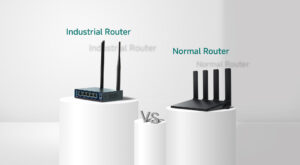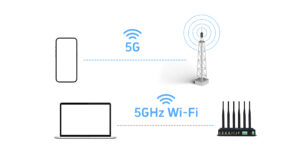In today’s fast-paced industrial environments, network reliability is critical. Whether in smart factories, remote oil fields, or automated warehouses, losing connectivity can mean costly downtime. This is where cellular access points come in—a game-changing solution that combines traditional Wi-Fi with 5G/4G LTE cellular backup to ensure uninterrupted operations.
Czym jest punkt dostępu komórkowego?
A cellular WiFi access point (also called a cellular wireless access point) is a networking device that provides both Wi-Fi and cellular connectivity. Unlike standard punkty dostępowe that rely solely on wired broadband, these devices integrate 5G/4G LTE modules, allowing them to switch seamlessly between wired and cellular networks when the primary connection fails.
Do najważniejszych cech nowoczesnych punktów dostępu komórkowego należą:
- Podwójna kopia zapasowa sieciowa – Automatic failover between wired and cellular broadband.
- Szybka łączność 5G – Utilizing 5G Sub-6GHz for IoT and eMBB (Enhanced Mobile Broadband) applications.
- Wsteczna kompatybilność – Support for 4G LTE and 3G when 5G is unavailable.
- Obsługa Wi-Fi 6 – Faster speeds, lower latency, and better performance in high-density environments.
Dlaczego aplikacje przemysłowe potrzebują punktów dostępu komórkowego
Industrial settings demand uninterrupted, high-bandwidth connectivity. Traditional Punkty dostępu Wi-Fi can fail due to fiber cuts, power outages, or interference. A 5G cellular access point solves this by providing:
1. Bezkonkurencyjna niezawodność dzięki podwójnej sieciowej kopii zapasowej
- If the primary wired connection fails, the device automatically switches to 5G/4G cellular without disruption.
- Critical for SCADA systems, remote monitoring, and automated machinery.
2. Szybka i nisko-opóźnieniowa sieć 5G dla przemysłowego Internetu rzeczy
- 5G NR (NSA & SA) support ensures ultra-fast data transfer for real-time analytics, AGVs (Automated Guided Vehicles), and AI-driven automation.
- The Qualcomm X62-based 5G module (used in leading models) delivers peak speeds and superior stability.
3. Przyszłościowa łączność
- 3GPP Release 16 compatibility ensures long-term support for evolving 5G standards.
- Wi-Fi 6 (802.11ax) enhances performance in crowded wireless environments.
Przykłady zastosowań punktów dostępu komórkowego w sieciach przemysłowych
- Inteligentna produkcja – Ensures real-time machine communication even if the main network goes down.
- Odległe miejsca wydobycia ropy i gazu – Provides last-mile connectivity where wired infrastructure is unavailable.
- Transport i logistyka – Keeps warehouse robots and tracking systems online 24/7.
- Zakłady użyteczności publicznej i inteligentne sieci energetyczne – Enables failproof monitoring of substations and pipelines.
Wybór właściwego punktu dostępu komórkowego
When selecting a cellular access point for industrial applications, consider:
- 5G kontra 4G LTE – 5G offers higher speeds, but 4G LTE may suffice for some use cases.
- Obsługa Wi-Fi 6 – Essential for high-density IoT deployments.
- Solidna konstrukcja – Look for IP67-rated, wide-temperature-range models for harsh environments.
- Bezproblemowe przełączanie awaryjne – Ensure automatic switching between wired and cellular networks.
Leading solutions in this space (including some cutting-edge models like Come-Star CIAP716N-6A25 incorporate 5G M.2 modules, dual-network backup, and industrial-grade durability, making them ideal for mission-critical operations.
Ostatnie przemyślenia
As industries embrace Industry 4.0, the demand for cellular internet access points will only grow. By combining Wi-Fi 6 and 5G cellular backup, these devices provide the redundancy, speed, and reliability that modern industrial networks require.
Whether you’re managing a smart factory, a remote mining site, or a large-scale logistics hub, a cellular wireless access point ensures that your operations stay connected—no matter what.


